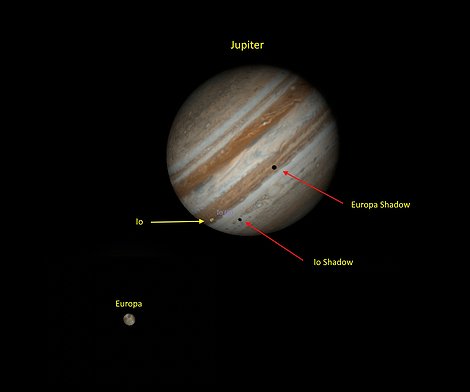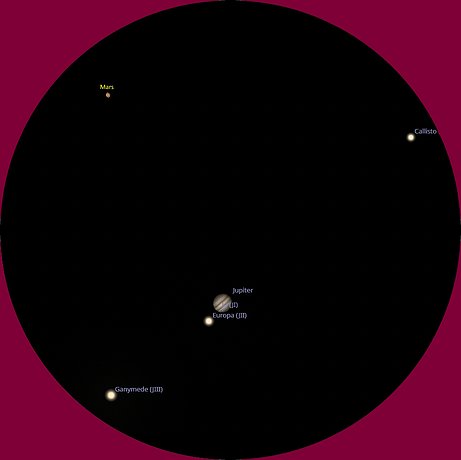Best Night Sky events for August
Get ready for arguably the best meteor shower of the year. The August night sky brings the famous Perseid Meteor Shower, followed by the Full Sturgeon Moon — a Blue Moon, a Supermoon. Plus, there’s a chance that a “new” star will appear in the night sky and there will be an ultra-close conjunction between Mars and Jupiter. Here is everything worth watching, including many picturesque planet-moon pairings and suggestions for telescopic observations.
Aug. 1-31 — A Possible Nova
A binary star system 3,000 light years away is set to become visible to the naked eye this year, in an event that will see its apparent brightness temporarily increase. T Coronae Borealis, also known as the "Blaze Star," last brightened in 1946, and astronomers have predicted it could brighten again between now and September 2024. This brightening event is known as a "nova," which means "new star" in Latin, so-called because it describes how a previously dim star can suddenly reach prominent naked-eye brightness in the sky. This star whose current brightness (10th magnitude) is just barely discernable through 50mm binoculars (at a dark sky location) could brighten to the same visible magnitude as the North Star Polaris. This is an increase in brightness of nearly 1,600 times. Look between the constellations of Corona Borealis and Hercules to see if something “new” has appeared.
Aug. 4 — New Moon
On Wednesday, Aug 4 at 4:13 a.m., the moon officially reached its new moon phase. The moon is now between Earth and the sun, and the side of the moon facing toward us receives no direct sunlight making it hidden from view from anywhere on Earth for about a day or two.
Aug. 9 — Moon and Bright Star Spica Conjunction
Look low in the western sky at 9 p.m. on this date to see the bright star Spica within 3 degrees of the Crescent Moon. Spica is the brightest star in the constellation of Virgo.
Aug. 11, 12 — Perseids Meteor Shower
The Perseids is one of the best meteor showers to observe, producing up to 90 meteors per hour at its peak. It is produced by the comet Swift-Tuttle, which was discovered in 1862. The Perseids are famous for producing a large number of bright meteors. The shower runs annually from July 17 to Aug. 24. It peaks this year on the night of Aug. 11 and the morning of Aug. 12. The first quarter moon will block out some of the fainter meteors in the early evening, but the moon will set shortly after 10:30 p.m., leaving dark skies for what could be an excellent late night and early morning show. Best viewing will be from a dark location after midnight. Meteors will radiate from the constellation Perseus but can appear anywhere in the sky. These meteors are colorful, and they frequently leave persistent trails called trains. All of these factors make the Perseid meteor shower perhaps the most spectacular meteor shower for the Northern Hemisphere.
Aug. 12 — First Quarter Moon
When the moon completes the first quarter of its journey around earth this morning at 8:19 a.m., its 90-degree angle between us and the sun will cause us to see the moon half-illuminated — on its eastern side, the right side.
At first quarter, the moon always rises around mid-day and sets around midnight, so it is also visible in the afternoon daytime sky. The evenings surrounding first quarter are the best evenings to use a telescope or even a pair of binoculars for seeing the lunar terrain which will be dramatically lit by low-angled sunlight, especially along the terminator, the pole-to-pole boundary that separates the light and dark hemispheres.
Aug. 13 — Moon and Bright Star Antares Conjunction
Look to the southwest around 9 p.m. to see the Gibbous Moon pass within one degree of the brightest star in the constellation of Scorpio, Antares. See if you notice the very orange color of Antares.
Aug. 14 — Mars and Jupiter Conjunction (this is very cool)
If you’re an early riser, watch Jupiter and Mars this morning at 3 to 4 a.m. as they will be separated by less than 20 arc minutes (0.33 degrees). In fact, they will be so close that you might have a hard time telling there’s two objects there with the naked eye.
This ultra close approach (visually, not physically) gives you opportunity using a small to moderate size telescope. You should use around 125x to see these two solar system companions, along with all of Jupiter’s Galilean moons in the same field of view. Compare the relatively tiny disk of Mars with that of Jupiter’s, which will appear some six times wider. Then, throughout the rest of the month, watch while Mars’ rapid motion carries it a full eight degrees east of Jupiter by Aug. 31.
At the same time as this ultra close approach, there is also a double moon transit across the face of Jupiter. This is a fairly rare occurrence and shouldn’t be missed if you have the equipment to observe it. Two of its moons' shadows from Europa and Io are causing two very black “ink” spots to march across Jupiter’s face. To see this, you need a moderate to large amateur telescope using at least 200x. A moderate-sized amateur telescope starts at 102mm (4 inches) of aperture and a focal length of 1000mm using a 9mm eyepiece and a 2x barlow to get the magnification up over 200x. An example telescope would be the Celestron NexStar 102 GT.
Aug. 19 — Full Moon, Blue Moon, SUPER Moon.
The moon will be located on the opposite side of the earth as the sun and its face will be fully illuminated. This phase occurs at 11:26 a.m. This full moon was known by early Native American tribes as the Sturgeon Moon because the large sturgeon fish of the Great Lakes and other major lakes were more easily caught at this time of year. This moon has also been known as the Green Corn Moon and the Grain Moon. Since this is the third of four full moons in this season (summer), it is known as a blue moon. This rare calendar event only happens once every few years, giving rise to the term, “once in a blue moon.” There are normally only three full moons in each season of the year. But since full moons occur every 29.53 days, occasionally a season will contain four full moons. The extra full moon of the season is known as a blue moon. Blue moons occur on average once every 2.7 years.
Because the moon is only 10 hours away from its closest approach to earth, this Full Moon will be the first Supermoon this year. It will appear 6.4% bigger and 12.8% brighter than the average Full Moon.
Aug. 20 — Saturn Near Miss with The Moon
Look east-southeast after dark, around 9:30 p.m. to see Saturn kissing the moon. They will be less than 1.5 degrees apart (that’s close). By late evening, Saturn is considerably higher for good telescopic observing — a bright, sedate point of light poised against the dim stars of Aquarius, the Water Carrier. Saturn doesn’t transit the meridian (reach its highest point in the sky) until well after midnight (2:07 a.m.), giving you ample time to get it in your sights.
Aug. 26 — Third Quarter Moon
The third (or last) quarter phase, occurring at 2:26 a.m., shows the moon appearing half-illuminated on its western, or left side. It rises around midnight local time, and then remains visible until it sets in the western daytime sky in the early afternoon. The dark, moonless evening skies that follow this phase are the best ones for observing deep sky targets.
Aug. 26 — The Moon and The Pleiades
Look low in the east at midnight on the 26th to see the third quarter moon’s closest approach to the star cluster the Pleiades. They will pass within 2.5 degrees from one another.
Aug. 27 — The Moon and Jupiter are Close
Once again if you are an early riser look for the moon and Jupiter to make a close approach, passing within 5.5 degrees of each other at around 3 a.m.
• • •
John Taylor is an amateur astronomer who lives in Hayden.





